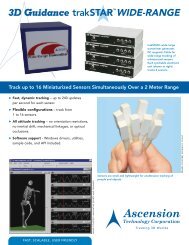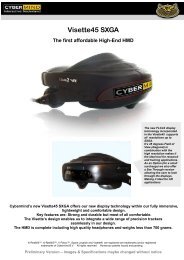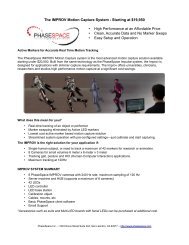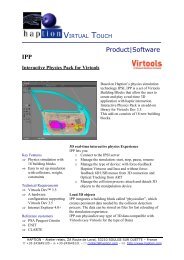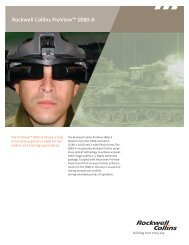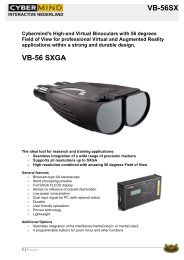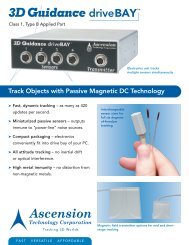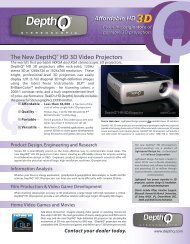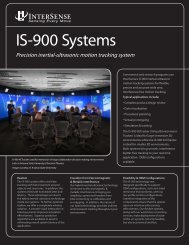PCTracker Technical Overview - EST Engineering Systems ...
PCTracker Technical Overview - EST Engineering Systems ...
PCTracker Technical Overview - EST Engineering Systems ...
You also want an ePaper? Increase the reach of your titles
YUMPU automatically turns print PDFs into web optimized ePapers that Google loves.
<strong>Technical</strong> <strong>Overview</strong><br />
<strong>PCTracker</strong><br />
Brief Introduction & Synopsis of the Operation of the <strong>PCTracker</strong><br />
The cost effective <strong>PCTracker</strong> is a new IS-900 configuration designed specifically to take advantage of<br />
fast, Windows-based computers running with modern graphics engines for the budget conscious user.<br />
The system is a 6 degree of freedom (6-DOF) motion tracking system based on a hybrid technology of<br />
inertial and ultrasonic tracking. The position and orientation of the tracking stations are determined by<br />
the output of the accelerometers and gyros. Drift correction is accomplished in our advanced Kalman<br />
filter by fusing the output of the inertial sensors with range measurements obtained from the ultrasonic<br />
components. The result is full 6-DOF data that is very smooth, precise, and free from jitter.<br />
Advantages of the <strong>PCTracker</strong> technology include:<br />
♦ Low cost system utilizes IS-900 technology for small area tracking<br />
♦ Immune to metallic, acoustic, and optical interference<br />
♦ Sensor design eliminates acoustic transmitter “line of sight” blockage<br />
♦ Consistent accuracy over entire tracking volume<br />
♦ Factory calibration for accurate position mapping of acoustic transmitters<br />
♦ Superior motion prediction algorithms<br />
♦ Integration of tracking devices into OEM applications<br />
<strong>PCTracker</strong> Configuration<br />
The <strong>PCTracker</strong> eliminates the need for an IS-900 processor. InterSense’s SensorFusion code for<br />
calculating the full 6-DOF tracking solution is performed by the standard InterSense Windows dynamic<br />
link library (isense.dll) running through InterSense’s IServer Windows Application Tray Software. The<br />
MiniTrax tracking devices and SoniStrips plug into the <strong>PCTracker</strong> Hub, which interfaces directly to the<br />
computer via its RS-232 serial port(s). The <strong>PCTracker</strong> Hub will support a maximum of two MiniTrax<br />
devices (2 serial ports required) and 3 SoniStrips (9 SoniDisc ultrasonic emitters).<br />
1 InterSense, Inc.<br />
36 Crosby Drive, Suite 150 ● Bedford, MA 01730<br />
+1 781 541 6330 ● FAX +1 781 541 6329<br />
http://www.intersense.com ● info@intersense.com
InterSense <strong>PCTracker</strong> <strong>Technical</strong> <strong>Overview</strong><br />
The standard <strong>PCTracker</strong> System (shown in Figures 1 & 2) includes one <strong>PCTracker</strong> Hub; one wired<br />
MiniTrax Head tracker; a fixed SoniFrame assembly made up of two 4 foot SoniStrips, and one 2 foot<br />
SoniStrip; and, the Windows IServer Software. The deliverable configuration is flexible allowing<br />
substitution of the SoniFrame with a SoniWing, and substitution of the MiniTrax Head Tracker with<br />
either a MiniTrax Hand Tracker or MiniTrax Wand.<br />
<strong>PCTracker</strong> Components<br />
The fixed frame SoniFrame assembly provides a 2 x 2 x 3 meter tracking volume with no special sighting<br />
or calibration of the SoniStrips. The three SoniStrips easily mount to the SoniFrame assembly to produce<br />
a repeatable rigid structure that is portable and convenient to use.<br />
The <strong>PCTracker</strong> System supports all Windows PC platforms and is powered by an external power supply<br />
included with the <strong>PCTracker</strong> Hub. Cables provided with the system include three Hub to SoniStrip<br />
cables, one Hub to Tracker cable and one straight through RS-232 serial cable to connect the Hub to the<br />
Windows Host PC. The <strong>PCTracker</strong> ships with an auto installer CD which provides the necessary<br />
InterSense library (isense.dll), IServer software, a full software development kit (SDK) with<br />
programming examples, and interface code needed to help developers interface to their application<br />
program.<br />
Application programs running on Windows operating systems that currently adhere to InterSense’s API<br />
are plug compatible with the <strong>PCTracker</strong>. The IS-900 Wireless Modules are not compatible with the PC<br />
Tracker.<br />
Figure 1 - <strong>PCTracker</strong> Components<br />
2 InterSense, Inc.<br />
36 Crosby Drive, Suite 150 ● Bedford, MA 01730<br />
+1 781 541 6330 ● FAX +1 781 541 6329<br />
http://www.intersense.com ● info@intersense.com
InterSense <strong>PCTracker</strong> <strong>Technical</strong> <strong>Overview</strong><br />
SoniFrame or SoniWing Constellation acoustic pulse transmitters<br />
The SoniFrame and SoniWing are a fixed constellation of ultrasonic SoniDiscs. Both fixed constellations<br />
do not require special measurement or calibration. The exact locations of the SoniDiscs are factory<br />
calibrated by InterSense and included in the ISDEMO Constellation Configuration Utility Program<br />
provided with the system.<br />
The SoniFrame (left) and SoniWing (right), shown in Figure 2, have ultrasonic SoniDisc transmitters that<br />
first receive addressed signals from the PC Tracker Hub and then transmit ultrasonic pulses in response.<br />
The acoustic transmission beam width for each SoniDisc provides wide-angle coverage (approx. 70degree<br />
cone angle) to maximize the tracking area.<br />
Figure 2 - <strong>PCTracker</strong> available with SoniFrame or SoniWing<br />
SoniFrame and SoniWing Mounting and Configuration<br />
The SoniFrame or SoniWing are typically mounted from the ceiling over the desired tracking workspace.<br />
To increase the flexibility of this system, the SoniFrame can be configured with different sized SoniStrips<br />
for mounting in a variety of small area immersive environments. The user is able to position either the<br />
SoniWing or SoniFrame SoniStrips in confined spaces as found in desktop environments, virtual<br />
workbenches, automobiles, and cockpit simulators. Once installed, the user must calibrate the SoniStrip<br />
Constellation by configuring the Cartesian x, y, z coordinates of each SoniDisc using the constellation<br />
Configuration Utility Program provided in the InterSense Program ISDEMO. ISDEMO has an easy to<br />
use INSERT function (Figure 3) that eliminates the need to measure beacon positions. Pull down menus<br />
allow the user to select the corresponding SoniStrip ID numbers, which then activates a predetermined<br />
constellation grid matched to the SoniStrip configuration assembled with the SoniFrame.<br />
3 InterSense, Inc.<br />
36 Crosby Drive, Suite 150 ● Bedford, MA 01730<br />
+1 781 541 6330 ● FAX +1 781 541 6329<br />
http://www.intersense.com ● info@intersense.com
InterSense <strong>PCTracker</strong> <strong>Technical</strong> <strong>Overview</strong><br />
The SoniFrame is included with the standard <strong>PCTracker</strong> system. Three SoniStrips easily mount to the<br />
SoniFrame assembly to produce a repeatable rigid structure that is portable and convenient.<br />
Tracking Station Description<br />
Figure 3 – ISDEMO Insert interface for installing a SoniFrame<br />
For InterSense motion tracking systems, a “station” is the tracked object or device, which in industry<br />
jargon is also called a sensor. An IS-900 tracks all stations in a 6-DOF mode, meaning each tracked<br />
device outputs an X, Y, Z position information along with a pitch, yaw and roll orientation information.<br />
In addition, the Wand Tracking Station outputs joystick and button information for use with the<br />
immersive environment software. Table 4 summarizes InterSense’s <strong>PCTracker</strong> Tracking Stations. A<br />
maximum of two, wired tracked stations can be used with one <strong>PCTracker</strong> System.<br />
Tracked Station Function<br />
MiniTrax Head Tracking Stations Stereo glasses and Head Mounted Display (HMD) mounted.<br />
An optional high accuracy version is available.<br />
MiniTrax Hand Tracking Station Right or left hand versions designed to mount on virtual reality<br />
interface gloves<br />
MiniTrax Wand w/ Joystick Tracking Station Five button with center push button joystick<br />
Table 4 – Choice of MiniTrax Tracked Stations for <strong>PCTracker</strong> (Maximum of two wired allowed)<br />
Each tracked station uses InterSense’s Serial Station Protocol to combine raw data from the InertiaCube<br />
(angular & acceleration rates) with acoustic range data for transmission to the InterSense .dll via the<br />
<strong>PCTracker</strong> Hub. InterSense provides different types of tracked stations for use in immersive<br />
4 InterSense, Inc.<br />
36 Crosby Drive, Suite 150 ● Bedford, MA 01730<br />
+1 781 541 6330 ● FAX +1 781 541 6329<br />
http://www.intersense.com ● info@intersense.com
InterSense <strong>PCTracker</strong> <strong>Technical</strong> <strong>Overview</strong><br />
environments. All of these tracked stations use InterSense’s advanced inertial MiniTrax technology<br />
combined with miniaturized digital acoustic position referencing components. The standard tracked<br />
stations include the MiniTrax 5-button wand with a center-click joystick, a MiniTrax Hand Tracker (left<br />
or right), a MiniTrax Head Tracker, and an optional High Accuracy MiniTrax Head Tracker.<br />
Figure 5 - <strong>PCTracker</strong> Hub<br />
In applications requiring two tracking stations, the <strong>PCTracker</strong> requires two RS-232 ports for interfacing to<br />
a Windows PC. As shown in Figure 5 of the <strong>PCTracker</strong> Hub, there are two RS-232 serial available for<br />
connection to the Windows host computer. When running with one tracking device, the single tracker is<br />
connected to Tracker Port #1 and the RS-232 Serial Port #1 is connected to the Window Host running<br />
IServer software. To add a second tracking device, the tracker is connected to Tracker Port #2 and a<br />
second serial cable is connected between RS-232 Port #2 on the <strong>PCTracker</strong> Hub and a second serial port<br />
on the same Windows Host Computer.<br />
5 InterSense, Inc.<br />
36 Crosby Drive, Suite 150 ● Bedford, MA 01730<br />
+1 781 541 6330 ● FAX +1 781 541 6329<br />
http://www.intersense.com ● info@intersense.com
<strong>Technical</strong> Information<br />
InterSense <strong>PCTracker</strong> <strong>Technical</strong> <strong>Overview</strong><br />
♦ Serial rate: 115.2 kbaud<br />
♦ Latency: 4 to 10 ms (without prediction and PC host dependent)<br />
♦ Interface: RS-232 (two RS-232 required for two tracked devices)<br />
♦ Protocol: InterSense API through the InterSense .dll, SDK available<br />
Device specifications<br />
Resolution (RMS)<br />
Wand Hand Tracker Head Tracker High Accuracy Head<br />
Tracker (Optional)<br />
Position (X/Y/Z) 0.75 mm 0.75 mm 0.75 mm 0.75 mm<br />
Angular (P/R/Y) 0.05˚ 0.05˚ 0.05˚ 0.05˚<br />
Static Accuracy<br />
Position 2.0 – 3.0 mm 2.0 – 3.0 mm 2.0 – 3.0 mm 2.0 – 3.0 mm<br />
Angular (P/R, Y) 0.25˚, 0.50˚ 0.25˚, 0.50˚ 0.25˚, 0.50˚ 0.25˚, 0.25˚<br />
Size (W x L x H) 10.0 x 17.0 x 5.5 cm 10.0 x 8.0 x 4.4 cm 9.4 x 2.7 x 2.7 cm 20.5 x 3.0 x 2.7 cm<br />
Weight 140g wired 44g 23g 38g<br />
General specifications and cable lengths<br />
♦ <strong>PCTracker</strong> Hub dimensions: 4.54 x 3.00 x 1.25 in (115.32 x 76.20 x 31.75 mm).<br />
♦ Maximum cable length between the PC and <strong>PCTracker</strong> Hub is 9 ft (2.74 m).<br />
♦ Maximum distance between <strong>PCTracker</strong> Hub and SoniFrame is 10 ft. (3.05 m) and SoniWing is 15 ft.<br />
(4.57 m).<br />
♦ Maximum cable length between tracking device and <strong>PCTracker</strong> Hub is 14 ft. (4.27 m).<br />
♦ The distance between the tracking devices and the SoniStrip array should not exceed 9 ft. (2.74 m).<br />
♦ Supported with the InterSense .dll (isense.dll) on Windows 98/NT/2000/ME/XP Operating <strong>Systems</strong>.<br />
<strong>PCTracker</strong> OEM Example Application<br />
In addition to InterSense’s standard tracked stations, there are also new OEM devices being delivered<br />
with some IS-900 systems that integrate the IS-900 MiniTrax technology into custom 3 rd party tracked<br />
stations. For example, the MiniTrax technology is successfully integrated into devices for multiple<br />
weapons systems and fire fighter training apparatus.<br />
One specific example for the <strong>PCTracker</strong> is a welding simulator system known as the WAVE project. In<br />
the welding domain, most of the training time is spent for gesture control. This costs a lot of raw material<br />
to the training organization and is a painful step for the trainee. InterSense partner Immersion SA has<br />
developed a virtual welding workbench for WAVE project. This project is supported in the Fifth<br />
6 InterSense, Inc.<br />
36 Crosby Drive, Suite 150 ● Bedford, MA 01730<br />
+1 781 541 6330 ● FAX +1 781 541 6329<br />
http://www.intersense.com ● info@intersense.com
InterSense <strong>PCTracker</strong> <strong>Technical</strong> <strong>Overview</strong><br />
Framework program by the European Commission in the IST initiative and is included in the cluster of<br />
projects EUTIST-AMI (www.eutist-ami.org) regarding Agents and Middleware Technologies applied in<br />
real industrial environments. WAVE is developed in partnership by CS and AFPA WAVE will be<br />
initially deployed in all AFPA welding centers in FRANCE in 2004.<br />
The primary goal of WAVE is to train students in mastering welding gesture. The main advantage is the<br />
reduction of raw material cost. WAVE is designed to introduce and familiarize students learning<br />
welding. It does not replace the real training, but will make up about a third of the overall training<br />
process.<br />
Figure 6 – WAVE Welding Simulator<br />
using <strong>PCTracker</strong> OEM Package<br />
Shown in Figure 6, the WAVE welding simulator is the first commercial application of the <strong>PCTracker</strong>.<br />
The WAVE virtual workbench runs on a standard PC platform with an adjustable flat panel monitor,<br />
which is positioned to simulate different welding procedures. As shown in Figure 6, the MiniTrax<br />
components are integrated into the torch and the SoniDiscs are embedded into the bevel of the virtual<br />
workbench. Since the workbench is required to track the torch at any angle, an encoder reports angle of<br />
the workbench and the proper normal vectors for the SoniDiscs are sent to the <strong>PCTracker</strong> software for<br />
dynamic configuration of the Constellation array.<br />
The WAVE architecture is designed for use in other networked training scenarios. Each workbench is<br />
monitored in real-time by a supervisor workstation. The supervisor workstation also acts as a central<br />
database and control manager to handle trainee information and results.<br />
7 InterSense, Inc.<br />
36 Crosby Drive, Suite 150 ● Bedford, MA 01730<br />
+1 781 541 6330 ● FAX +1 781 541 6329<br />
http://www.intersense.com ● info@intersense.com



